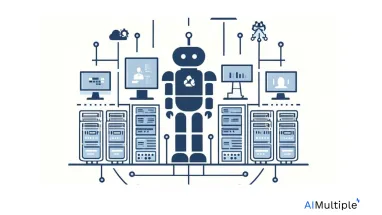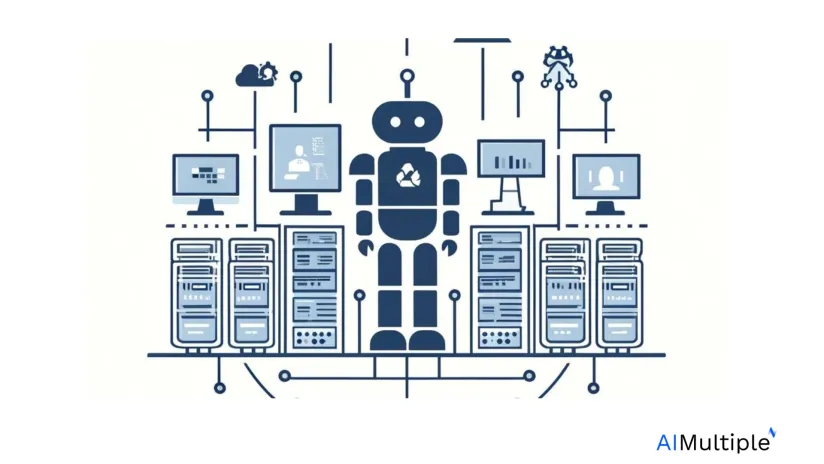Many tasks in IT, HR, and finance are repetitive, data-based, and labor intensive, which makes the back-office a great candidate for automation using AI and RPA, and workload automation. According to research, RPA in the back office can reduce 40% of the cost of employees, providing a quick and tangible ROI to organizations.1
Applying AI and automation tools to back-office processes
AI, RPA, WLA, and analytics contribute to optimizing task automation in the back office tasks by handling repetitive tasks while leveraging cognitive abilities:
- Robotic process automation: RPA is one of the fastest to implement yet customizable technology solution. Bots can be programmed to completely handle repetitive, time-consuming tasks, reducing manual error and providing faster results.
- Workload automation: Workload automation (WLA) tools schedule, trigger, execute, and monitor workflows across different business platforms from a centralized point. Monitoring back-office workflows improves the overall data management and compliance.
- Analytics: Applying analytics to back-office data identifies ways to improve the company’s performance
- Process mining / task mining: Specific analytics approaches such as these technologies help understand their processes better and identify ways to improve them
- Image recognition and computer vision enabled document automation: These enable the processing of unstructured back-office data, such as financial and procurement invoices, reports, and employees handwriting.
- Natural language processing: NLP enables the use of chatbots as digital assistants facilitating back office tasks like booking vacation requests or other HR queries.
- Machine learning: ML algorithms can learn from both structured or unstructured back office data:
- Supervised ML algorithms can use this data to train predictive models of processes such as digital twin of an organization.
- Unsupervised ML algorithms can find patterns in data, enabling anomaly detection of system and operational errors, as well as best and worst practices in different processes.
Back-office automation examples
Tasks such as contract approvals, employee onboarding and invoicing are common among all back-office departments. However, department-wise automatable tasks are:
Finance department
RPA bots can automate ±42% of finance operations in accounting such as:
- Account payable
- Account receivable
- Client reporting
- Controlling
- Financial reporting
- Record keeping
- Payroll automation
Accounts payable is a good example in terms of including the areas where back office automation such as invoicing is required. Companies can also apply to ERP suites for this type of back-office automation. However, these suites can remain repetitive in tasks such as reporting. For this reason, companies can use plug-ins to improve back-office automation in accounts payable:
- Dynamics 365 in Accounts Payable Automation
- Blackbaud Accounts Payable (AP) Automation
- Sage Accounts Payable (AP) Automation
- Accounts Payable ERP Integration
- NetSuite AP Automation
Other AI solutions in financial back offices include applying:
- Analytics for:
- internal, external, and compliance auditing
- identification of material misstatements in the general ledger
- Language understanding algorithms for contract reviews to identify non-compliant terms
- Image recognition for double checking invoices and financial statements, and eliminating duplicates
IT department
IT tasks automation, also called ITPA, can benefit from RPA in these areas:
11) Installing software
Bots can be trained to:
- Automate software requests and approvals
- Download licensed software
- Install and update available software on pre-assigned servers and user machines
12) Monitoring servers and applications
- Monitor and save server performance data
- Prepare reports
13) Alerting
Bots can automate notifications of server issues and downtime. In addition, analytics’ reports can identify recurring errors and downtimes, making it easier for the IT department to spot future bugs.
WLA tools on the other hand, can monitor the workflow execution, detect failures in execution and trigger alarms to notify users of errors.
14) Data migration
Bots can recognize required files and formats which need to be migrated from one system to another, and input them into pre-defined folders in the designated system. Bots can also retain migration data in a log to allow system user to check the process, and input and output system data.
15) Data backup
Bots can automate data backup, recovery, and restoration. On the other hand, leveraging image recognition and computer vision can limit backing up duplicate data which might be named differently.
16) Batch processing
Batch processing means processing of multiple transactions, simultaneously, and in a sequential order. Bots can handle batch processing such as:
- Synchronizing, deleting, and emptying folders
- Creating and sending notifications to users
Workload automation tools can also be used to perform batch processes (e.g. ETL, FTP) as they can schedule, initiate, and execute processes at certain time schedules or triggering events.
17) Creating and updating user emails
Bots can create user emails, update user information from HR lists, and add specific employees to position-relevant mailing lists.
18) Creating and resetting user passwords
Bots can create, passwords for new user emails, devices, and software accounts, as well as reset and verify passwords of existing users.
19) Reduce cybersecurity threats
Bots can eliminate unauthorized logins, automate detection of viruses and hacks, as well as limit human involvement in managing sensitive or privileged data.
Others
RPA bot can:
- Manage service requests automatically
- Automate asset management
- Automate job scheduling
- Optimize storage capacity
- Automate onboarding process
- Automate offboarding process
HR department
RPA bots can improve task efficiency and reduce HR operation time, as well as enhance employee satisfaction. RPA use cases in HR include:
- Candidate sourcing
- Employment history verification
- Arranging interviews
- Administer Offer Letters
- Onboarding automation
- Travel & Expense Management
- Attendance Management
- Payroll Management
- Managing employees’ data
- Aggregating data for performance reviews
- Managing employee offboarding
On the other hand, analytics in HR can:
- Improve hiring
- Improve retention
- Use aggregated employee performance data for objective auditing and scoring
- Provide insight about employee’s motivation and productivity, as well as company culture
To learn more about RPA and analytics in HR, feel free to read our detailed articles What is RPA for HR? – Top 9 RPA use cases in HR and Setting up analytics in HR
Supply chain
Supply chain processes produce numerous documents in different formats, such as delivery orders, dock receipts, bill of lading (B/L), etc. Processing and storing these documents is necessary to maintain efficiency and compliance in supply chain back offices. Automation solutions include:
- Leveraging AI/ML, image recognition, and OCR in document automation for data capturing, clustering information on the document, and sending the document to relevant employees.
- Applying analytics to supply chain data for planning staff and inventory programs.
- Using augmented reality applications for warehouse planning and operations, transportation optimizations, and inventory management.
To learn more about implemented technologies in the supply chain department, feel free to read our in-depth article Supply Chain Automation
Benefits of back-office automation
Implementing automation solutions in the back-office enables:
- Reduction of administrative errors
- Enhanced communication among business departments
- High ROI:
- Bot licensing costs between €3,000-€8,000 annually, on the other hand, hiring a full-time employee (FTE) will cost the company €30,000+ but this depends highly on the country
- Analytics benefits
- Back office employees process large volumes of data resulting in a rich, multi-format database about the business, enabling statistical and predictive analysis of organization’s processes. This can be beneficial for implementation of process mining and modeling a digital twin of an organization.
For more on automation
To learn more about automation, read:
- Guide to Hyperautomation: Technologies, Pros & Cons
- Top 12 Hyperautomation Use Cases & Examples
- Front Office Automation: 5 Ways To Boost Customer Satisfaction
To learn more about RPA use cases in different business departments, download our in-depth whitepaper on RPA:
If you are looking to buy off-the-shelf RPA solutions for your business, benefit from our data-driven list of RPA vendors, and contact us to help you



Comments
Your email address will not be published. All fields are required.